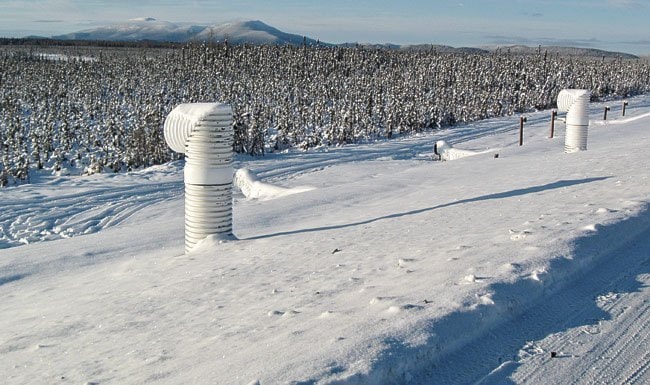Melting permafrost is wreaking havoc on Yukon highways.
With Hundreds of kilometers of roads built on permafrost, this has become a huge engineering challenge for the territory, said Allan Nixon an assistant deputy minister for highways and public works.
But the department’s accepted the challenge.
On a 600-metre stretch of the Alaska Highway near Beaver Creek, studies are underway to find ways to mitigate the problem.
They are testing four different techniques.
Each has benefits and drawbacks.
The researchers aren’t looking one-size-fits-all solution. They’re trying to draft guidelines about what to do and where, said Guy Dore, a professor of civil engineering from Laval University, who is working on the project.
“There’s no technique that’s universal,” he said.
Of the territory’s 4,800 kilometers of highway, about 25 per cent is built on permafrost.
And that can get expensive
It costs about eight times more to maintain a road built on permafrost. And so, in the Yukon, those maintenance costs add up.
Permafrost is defined as ground that stays frozen for two years of more.
Identifying such areas is a challenge.
Permafrost is usually covered with an “active layer” that freezes in the winter and thaws in the summer.
There is little noticeable difference on the surface. So you have to dig to find it.
While there is technology, like ground-penetrating radar, that can identify permafrost, currently those techniques are unreliable, said Dore.
“It’s an interpretation of a signal, and that can be kind of fuzzy,” he said.
The problem with permafrost is that is can be unstable.
Its stability depends on maintaining equilibrium with the atmosphere, said Dore.
While climate change is a factor in this melting, the disruption caused by building something, like a road, has a far greater effect on the frozen ground.
“If you change something on the surface you change the balance,” said Dore.
As the subsurface melts roads sink, crack and heave. That drives up the maintenance costs.
Which is why researchers are now experimenting with ways to keep permafrost cold.
There are a number of things being tried
One involves running pipes under the surface of the road to vent warm air out.
They are also looking at ways to better insulate the subsurface with either crushed rock or a synthetic “geocomposite” layer.
On the surface, they are experimenting with snow shields, grass and light colored road surfaces to keep things cool.
“We don’t think that there’s a magic bullet,” said Nixon. “We’re finding answers, not the answer.”
With $2.7 million in funding from both Canadian and American governments, the research at Beaver Creek will continue for at least five years.
Contact Josh Kerr at joshk@yukon-news.com
